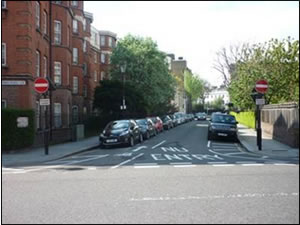Contraflow Cycling In Putney
The debate continues with Putney's Society David Irwin
The recent letter from Putney Society’s transport panel, suggesting contraflow cycling on the streets adjacent to the High Street, has prompted a lively discussion on the Putney SW15.com forum.
As of Friday the 11th October the number of postings had reached 245, outperforming any other forum topic currently under discussion. Many of the postings have lost sight of the original suggestion and have strayed into a more general debate about the merits of cycling. However, major questions have arisen, answers to which are given below.
Question 1 : Are the concerned one way roads wide enough to allow two way cycling ? The roads identified are Disraeli, Werter, Montserrat, Norroy and Chelverton Roads.
Answer : Disraeli, Werter and Montserrat Roads are certainly wide enough. Norroy and Chelverton are less wide, but since cyclists are cycling in the correct direction it can be presumed that the width is sufficient to allow them to cycle in the wrong direction. Indeed, it would be safer for them to do so as both cyclist and driver are able to see each other and take appropriate action to pass one another. The same logic applies to cyclists being hit by car doors opening. Those responsible for opening the door are better able to see an oncoming cyclist, moreover, should a collision occur the impact is reduced by the door swinging to a closed position.
Question 2 : Is contraflow cycling safe for pedestrians who might not look in both directions when crossing the road ?
Answer : Pedestrians look in both directions when crossing a two way road, therefore it follows that if they are aware that road is two way for cyclists they will behave in a similar manner.
Question 3 : Has contraflow cycling been introduced elsewhere in London, and if so, what is the outcome ?
 Answer : Yes, the Royal Borough of Kensington and Chelsea have 16 sections of one-way street where cyclists can travel in both directions, as well as other roads with older contra flow lanes. They plan to extend contraflow cycling across the borough to other appropriate one-way streets in order create new “Quietways” for cyclists – a key part of the Mayor’s Vision for Cycling. The concerned streets do not include a designated cycle lane except at the no entry point for vehicles, see photo. All that is required is an additional sign exempting cyclists. The council monitored road safety statistics and found that two-way cycling in one-way roads poses no more of a danger to motorists, pedestrians or cyclists than traditional contra flow schemes.
Answer : Yes, the Royal Borough of Kensington and Chelsea have 16 sections of one-way street where cyclists can travel in both directions, as well as other roads with older contra flow lanes. They plan to extend contraflow cycling across the borough to other appropriate one-way streets in order create new “Quietways” for cyclists – a key part of the Mayor’s Vision for Cycling. The concerned streets do not include a designated cycle lane except at the no entry point for vehicles, see photo. All that is required is an additional sign exempting cyclists. The council monitored road safety statistics and found that two-way cycling in one-way roads poses no more of a danger to motorists, pedestrians or cyclists than traditional contra flow schemes.
Question 4 : What are the implications of one way streets for Barclay’s Bikes ?
Answer : Bays for Barclay’s Bikes are under construction on various streets in Putney, including Disraeli and Montserrat Roads as well as Esmond Street, all of which are one way. The success of the Bikes will depend on easy user access and if current traffic directions remain unchanged it is likely that the number of cyclist illegally cycling in the wrong direction will significantly increase.
Question 5 : Should cyclist have impunity for breaking traffic regulations ?
Answer : Of course not. However a considerable number of cyclist currently cycle in the wrong directions on the concerned streets. Thus far there have been no serious accidents, nor has there been any action taken against wrongdoers. Why not legalise what is happening and thereby lessen the risks for all concerned as well as warning all road users of changed circumstances ?
Question 6 : Finally, why bother ? Why not leave things as they are ?
Answer : London’s traffic congestion is serious and has prompted the Greater London Authority and all London Boroughs to adopt policies to promote sustainable transport. Cycling is an important component of this policy and hence any measure to encourage drivers to cycle instead is a positive step towards creating a more healthy and liveable environment. At present only 4% of journeys in London are by cycle. This compares unfavourably with other cities in UK, for example, 18% in York and 28% in Cambridge. European cities are more cycle friendly. Of all journeys the percentage by cycle is 13% in Berlin, 15% in Munich, 23% in Copenhagen, and 37% in Amsterdam.
David Irwin
On behalf of the Putney Society
October 22, 2013